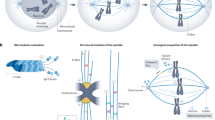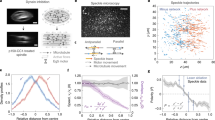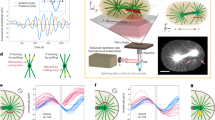Abstract
The architecture and adhesiveness of a cell microenvironment is a critical factor for the regulation of spindle orientation in vivo1,2. Using a combination of theory and experiments, we have investigated spindle orientation in HeLa (human) cells. Here we show that spindle orientation can be understood as the result of the action of cortical force generators, which interact with spindle microtubules and are activated by cortical cues. We develop a simple physical description of this spindle mechanics, which allows us to calculate angular profiles of the torque acting on the spindle, as well as the angular distribution of spindle orientations. Our model accounts for the preferred spindle orientation and the shape of the full angular distribution of spindle orientations observed in a large variety of different cellular microenvironment geometries. It also correctly describes asymmetric spindle orientations, which are observed for certain distributions of cortical cues. We conclude that, on the basis of a few simple assumptions, we can provide a quantitative description of the spindle orientation of adherent cells.
This is a preview of subscription content, access via your institution
Access options
Subscribe to this journal
Receive 51 print issues and online access
$199.00 per year
only $3.90 per issue
Buy this article
- Purchase on Springer Link
- Instant access to full article PDF
Prices may be subject to local taxes which are calculated during checkout




Similar content being viewed by others
References
Fuchs, E., Tumbar, T. & Guasch, G. Socializing with the neighbors: Stem cells and their niche. Cell 116, 769–778 (2004)
Lu, B., Roegiers, F., Jan, L. Y. & Jan, Y. N. Adherens junctions inhibit asymmetric division in the Drosophila epithelium. Nature 409, 522–525 (2001)
Grill, S. W., Howard, J., Schaffer, E., Stelzer, E. H. & Hyman, A. A. The distribution of active force generators controls mitotic spindle position. Science 301, 518–521 (2003)
Colombo, K. et al. Translation of polarity cues into asymmetric spindle positioning in Caenorhabditis elegans embryos. Science 300, 1957–1961 (2003)
Yamashita, Y. M., Jones, D. L. & Fuller, M. T. Orientation of asymmetric stem cell division by the APC tumor suppressor and centrosome. Science 301, 1547–1550 (2003)
Thery, M. & Bornens, M. Cell shape and cell division. Curr. Opin. Cell Biol. 18, 648–657 (2006)
Lechler, T. & Fuchs, E. Asymmetric cell divisions promote stratification and differentiation of mammalian skin. Nature 437, 275–280 (2005)
Gong, Y., Mo, C. & Fraser, S. E. Planar cell polarity signalling controls cell division orientation during zebrafish gastrulation. Nature 430, 689–693 (2004)
Siegrist, S. E. & Doe, C. Q. Extrinsic cues orient the cell division axis in Drosophila embryonic neuroblasts. Development 133, 529–536 (2006)
Thery, M. et al. The extracellular matrix guides the orientation of the cell division axis. Nature Cell Biol. 7, 947–953 (2005)
Mitchison, T. J. Actin based motility on retraction fibers in mitotic PtK2 cells. Cell Motil. Cytoskeleton 22, 135–151 (1992)
Grill, S. W., Kruse, K. & Julicher, F. Theory of mitotic spindle oscillations. Phys. Rev. Lett. 94, 108104 (2005)
Pecreaux, J. et al. Spindle oscillations during asymmetric cell division require a threshold number of active cortical force generators. Curr. Biol. 16, 2111–2122 (2006)
Izumi, Y., Ohta, N., Hisata, K., Raabe, T. & Matsuzaki, F. Drosophila Pins-binding protein Mud regulates spindle-polarity coupling and centrosome organization. Nature Cell Biol. 8, 586–593 (2006)
Du, Q. & Macara, I. G. Mammalian Pins is a conformational switch that links NuMA to heterotrimeric G proteins. Cell 119, 503–516 (2004)
Sanada, K. & Tsai, L. H. G protein βγ subunits and AGS3 control spindle orientation and asymmetric cell fate of cerebral cortical progenitors. Cell 122, 119–131 (2005)
Cuvelier, D., Rossier, O., Bassereau, P. & Nassoy, P. Micropatterned “adherent/repellent” glass surfaces for studying the spreading kinetics of individual red blood cells onto protein-decorated substrates. Eur. Biophys. J. 32, 342–354 (2003)
Piel, M., Meyer, P., Khodjakov, A., Rieder, C. L. & Bornens, M. The respective contributions of the mother and daughter centrioles to centrosome activity and behavior in vertebrate cells. J. Cell Biol. 149, 317–330 (2000)
Acknowledgements
Acknowledgments We thank A. Pépin and Y. Chen for technical help with micropattern fabrication, J.-B. Sibarita for technical help with video-microscopy, D. Grunwald for technical help with confocal image acquisitions and Y. Bellaïche for discussions.
Author Contributions M.T. performed experimental work, A.J.-D. performed numerical calculations, V.R. designed the software for movie analyses, and M.T., A.J.-D., M.B. and F.J. conceived the theoretical model.
Author information
Authors and Affiliations
Corresponding authors
Ethics declarations
Competing interests
Reprints and permissions information is available at www.nature.com/reprints. The authors declare no competing financial interests.
Supplementary information
Supplementary Information
This file contains Supplementary Text with the full description of the model, Supplementary Discussion, Supplementary Figures S1- S3 with Legends and additional references. (PDF 1546 kb)
Rights and permissions
About this article
Cite this article
Théry, M., Jiménez-Dalmaroni, A., Racine, V. et al. Experimental and theoretical study of mitotic spindle orientation. Nature 447, 493–496 (2007). https://doi.org/10.1038/nature05786
Received:
Accepted:
Published:
Issue Date:
DOI: https://doi.org/10.1038/nature05786
This article is cited by
-
CDK1–cyclin-B1-induced kindlin degradation drives focal adhesion disassembly at mitotic entry
Nature Cell Biology (2022)
-
Spindle positioning and its impact on vertebrate tissue architecture and cell fate
Nature Reviews Molecular Cell Biology (2021)
-
Tailoring cryo-electron microscopy grids by photo-micropatterning for in-cell structural studies
Nature Methods (2020)
-
Artificially decreasing cortical tension generates aneuploidy in mouse oocytes
Nature Communications (2020)
-
Are microtubules tension sensors?
Nature Communications (2019)
Comments
By submitting a comment you agree to abide by our Terms and Community Guidelines. If you find something abusive or that does not comply with our terms or guidelines please flag it as inappropriate.



